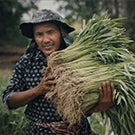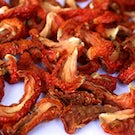Steam rises from the top of towering piles of compost at a landfill in western Placer County, California. The jaws of an excavator rake up and churn the heaps, unleashing a stench of decomposing food.
Some of the food in these piles has only recently arrived from nearby restaurants, supermarkets and food processors. Sweet potatoes, oranges, butternut squash and red onions look as if they were edible when they were tossed into the garbage.

“Even if something is only slightly blemished, you’ll find that grocery stores will take it off the shelves because they know it won’t move,” said Eric Oddo, program manager with the Western Placer Waste Management Authority. He sees this waste every day and blames consumers’ desire for perfect-looking produce.
READ MORE: Unfold, the official UC Davis podcast, examines how and why food gets wasted on the farm and in the supply chain.
Nearly one-third of all the food produced in the world is never eaten. By some estimates, we waste 30 million tons of food in the U.S. and 1.3 billion metric tons worldwide every year. All this waste has huge economic, environmental and social costs.
“It’s equally shocking and saddening that there are so many places where folks don’t have enough to eat and we’re throwing away perfectly good food,” said Oddo. The United Nations Food and Agriculture Organization estimates that about 815 million people in the world are chronically undernourished.

Explore more stories on food and agriculture
Growing food also uses resources: 20 percent of our land, 32 percent of the energy we produce and 70 percent of the water we withdraw from lakes, rivers and underground. When we waste food, we’re wasting those resources. It ends up in our landfills, creating pollution and greenhouse gases.


“When people hear those numbers, they think there’s an easy solution — that we should just stop wasting food,” said Ned Spang, an assistant professor in the Department of Food Science and Technology at the University of California, Davis. “It’s not that easy. We’re just starting to scratch the surface in really understanding the dynamics of this complicated problem.”
Spang led a team of researchers examining global food loss and waste in a study published in the journal Annual Reviews of Environment and Resources. The comprehensive review finds that there are larger systemic factors that drive food waste. The study points to the need to look at structural, cultural and social factors rather than only focusing on actions by individual producers and consumers.
Losses on the farm
Food waste isn’t only what consumers scrape off their plate or leave to rot in their refrigerator. It begins on the farm and can be driven by a whole host of factors beyond the grower’s control. Weather, pests, disease, low market prices or high labor costs all lead to food left in the field. Food that may look perfectly ripe and edible in the field may be too ripe by the time it reaches the consumer, so it’s never harvested.
“People see food left in the field after harvest and think farmers are being wasteful,” said Spang. “It’s an unfair characterization because it really does not make sense to harvest a crop if it’s not going to get eaten.”

It’s not just consumers that are picky about their produce. Market-based quality or grade standards also play an unintentional role in food waste.
“A lot of the criteria are based on the appearance of the product and may not have anything to do with eating quality or utility of the product,” said Elizabeth Mitcham, a postharvest extension specialist and director of the Horticulture Innovation Lab at UC Davis.
Those standards mean food is left in the field if it isn’t the right size, shape, color or maturity.
Losses after harvest
In developed countries, an estimated 20 percent of food is wasted on the farm or from improper or inadequate drying, storage, packaging and transportation.
Losses after harvest are most pronounced in less-developed countries, where an estimated 30 percent of food is wasted.
In tropical countries where humidity is an issue, food can rot or mold quickly if not dried properly or cooled. Growers and distributors often can’t afford the energy costs of drying, adequate storage or refrigerated transportation. Inadequate road infrastructure can also lead to higher levels of spoilage.
Solutions to Farm-Level and Postharvest Food Waste
One potential solution to on-farm losses is to have groups and organizations collect leftover crops to distribute to food banks, a practice called gleaning. The problem is that the scale of food recovery through gleaning is very small compared to what is lost.
“Identifying solutions that can work on a large scale is the real challenge,” Spang said.
Relaxing cosmetic quality standards for fruits and vegetables could prevent waste on farms on a large scale. Still, it would require consumers to overlook blemishes, bruises or imperfect produce so that there is a market for growers.


Spang’s study shows that training and education about packaging, storage and transportation helps prevent waste after harvest but would still require significant investment in developing countries.
Researchers at the Horticulture Innovation Lab at UC Davis developed a simple and low-cost solution to reduce spoilage of dried foods, the DryCard. The DryCard is about the size of a business card with a strip of cobalt chloride paper on it that changes color based on humidity. Read more about how the innovation can help reduce food loss globally.
Retail and consumer waste
Supermarkets, restaurants and consumers are responsible for the majority of food waste in the U.S. and other developed countries. Grocery stores contribute to food waste by encouraging consumers to buy more than they need, overstocking shelves, inaccurately predicting shelf life or damaging products. Restaurants also waste food by mismanaging inventory, poor menu choices or oversized portions.
Retailers that sell only in large quantities are also feeding our food waste problem.
“It's a lot of food that can easily go to waste,” said Mitcham. “Unfortunately, the costs are so low that sometimes it's cheaper to buy way more than you need than it is to buy a reasonable quantity, so it tends to drive consumer behavior in that direction.”

Consumers also misinterpret “sell by” or “best if used by” dates on food packaging to mean the food will no longer be safe to consume after those dates. Instead, the dates are the manufacturer’s recommendation for quality, not safety. Read more on date labels here.
Spang said there are also social and cultural factors that need to be considered when looking at consumer food waste.
“You can’t just look at a household’s waste and blame the family,” said Spang. “Food might go to waste because people are too busy to cook and misjudge the amount of food they need. They may live in rural areas and have to stock up and buy too much food rather than frequently driving long distances.”
Spang said in many cultures, running out of food is socially unacceptable, so better to have too much food than too little.
Solutions to retail and consumer waste
Solutions to prevent food waste can be just as complex as the causes. Studies have shown that smaller portions in restaurants and the foodservice industry reduce food waste.
Awareness campaigns for consumers about food waste show results, but the programs need to address how people relate to their food in everyday life.
“The good news is that the issue is receiving increasing attention from government, industry and academia at the global, national and local scales,” said Spang. “Despite its complexity, there are many established and emerging opportunities for targeted solutions to reduce, recover and recycle food waste across the food supply chain.”
Learn more about food recovery and recycling solutions from the UC Davis Food Loss and Waste Collaborative.
Learn about properly storing fruits and vegetables here or listen to Season 1, Episode 3 of Unfold, a UC Davis podcast.

Related Stories

Agricultural Innovations Help Cambodian Farmers Thrive
Small-scale farmers in Cambodia are working with researchers from the UC Davis and Cambodia’s Royal University of Agriculture (RUA) to test new methods, like the packinghouse, for growing and selling produce locally.

Moringa, the Next Superfood?
The "miracle tree," as it is sometimes described, shows great potential as a solution for a healthful, sustainable food supply for a rapidly growing global population.

Dry Card: Inventing a Low-Cost Solution to Reduce Food Waste
Introduced in 2017, the DryCard is helping prevent food spoilage globally, and was awarded the 2018 UC Davis Chancellor's Innovators Award.
Media Resources
Media Contacts: Amy Quinton, UC Davis News and Media Relations, 530-752-9843, cell 530-601-8077, amquinton@ucdavis.edu
